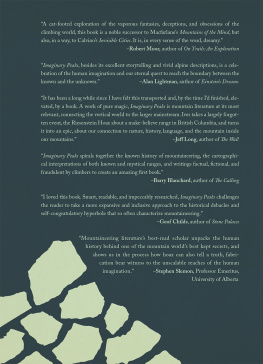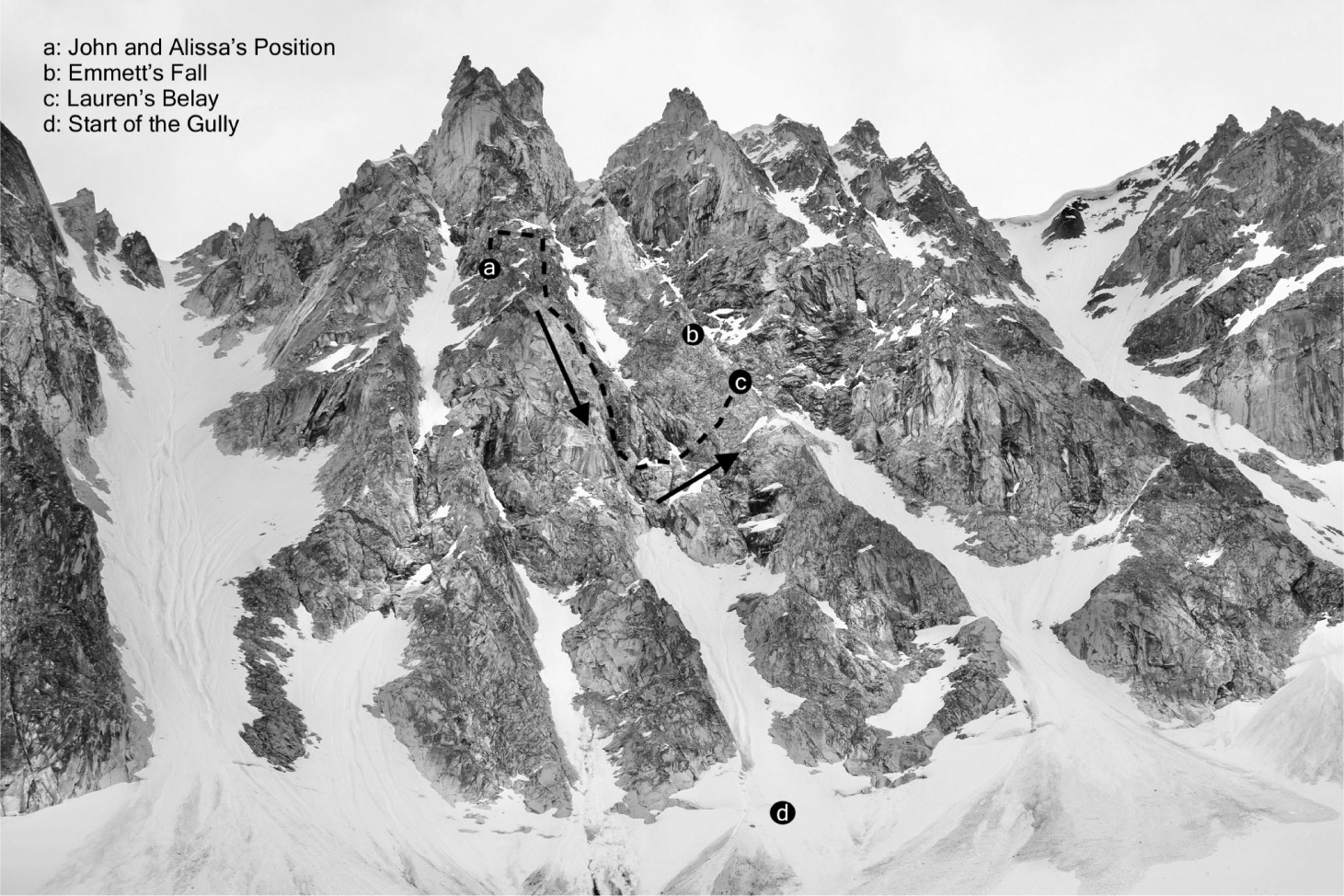DURING THE INTERVIEWS I CONDUCTED FOR THIS BOOK, I SOMETIMES encountered discrepancies in subjects recollection of events. This is natural: Our minds and memories often betray us in stressful situations. I feel I have presented as accurate an account as possible, though I must also acknowledge my own subjectivity. In this same vein, I claim responsibility for any mistakes, however slight.
I have either omitted or changed a few names in this book to protect some subjects, both for personal and professional reasons. Most notable among these is Lauren Weber. For the same reasons, no photographs of her appear in these pages.
I n the summer, the sun dances around the granite spires of Alaska, projecting shadows here, casting light there, though it never sets. On June 23, 2018, two days after the summer solstice, the sun came around a corner of ridgeline deep in the Hidden Mountains, a phalanx of peaks so remote they had no names or history. Tucked on the far western end of the Alaska Range, the Hidden Mountains were thin needles of rock capping a wild landscape. The mountains promised nothing apart from adventure in a world where adventure was becoming hard to find.
The rotting snow and dark rock of the peaks always seemed to have a gray shield of cloud hanging above them. On June 23rd, though, the cloud bank had wafted out to the ocean, the weather was clear and blue, and the wind was still. If you had been a raven or a bush pilot and had dipped your wings in order to level off and stare across at one of these unnamed spines of granite, you could have made out the unmistakable dots of four climberstwo teams of twostrung together by neon climbing rope, the bright colors of synthetic and nylon jackets and foam climbing helmets contrasting against the dark rock. Bits of humanity enveloped in wilderness and quiet.
All day long, Emmett Lyman and Lauren Weber had been climbing in the shade. Finally, at around seven oclock in the evening, the couple was rewarded by the sunlight as it poked through the spires. On the opposite ridgeline, two other specks of color climbed upward. These were John Gassel and Alissa Doherty. Occasionally the two parties whooped and hollered to each other, though the complicated terrain meant one team could rarely glimpse the other. The four climbers were close friends; both teams were couples. John and Alissa had even introduced Emmett and Lauren on a sun-drenched weekend of rock climbing in New York State.
They ranged in age from Alissa, the youngest, who was twenty-nine, to Emmett, the oldest, who had just turned forty. Each had successful, ambitious careers back in Boston, but they climbed as often as they could. Together they had traveled all over the globe, climbing frozen waterfalls in Canada, overhanging rock caves in Thailand, the desert spires of the Southwest. This trip felt special, though, because this mountain had never been climbed. So far as they could tell, even the cirque theyd hiked intoa snowy basin ringed with similarly untouched peakshad never seen a human footprint. Seven hundred feet below them, the climbers tents dried out in the sun, dwarfed by mountains that rose from snowfields and glacial rivers and the thick alders theyd struggled up the week before.
Emmett, Lauren, John, and Alissa hadnt planned on heading up this valley, but their original objective, a mountain several miles to the west, had proven too difficult to get to. They had spent four days ferrying loads of gear and crossing rivers swollen with snowmelt only to realize theyd likely run out of time to pursue their planned objective. A bush pilot was slated to pick them up on a gravel bar thousands of feet below on June 27th. But to the east lay another cirque of intriguing mountains, smaller and easier-looking. Why not notch a few quick first ascents instead of one? Climbing was always better than not climbing, especially when theyd invested so much effort getting here. Short on time, they headed east and trudged up two thousand feet to this current group of mountains instead.
The mountain they chose from this ring was unnamed, but Emmett started calling it Mount Sauron because the dark, twin-tipped summit spires reminded him of Saurons foreboding tower in Lord of the Rings. Saurons summit was only sixty-five hundred feet above sea level. From where the group had crouched in their cook tent, melting snow and boiling water, the peak rose fifteen hundred feet above the snowfield. Rocky ridgelines swept down from its twin summits. Between these, snowfields eased back down to the basin where they camped, like the indentations between knuckles on a hand.
On June 22nd, the day before their climb, it had rainedthe only crummy day of the trip. The foul weather had confined the couples to their tents. The gullies came alive with small, wet-slide avalanches, less dramatic than huge storm slabs but capable of knocking climbers off their feet all the same. Small rocks and debris bounced down the gullies, punctuating the light drum of rain against the tents.
But the next day, the sun shone clear and the two teams packed up, throwing climbing shoes, harnesses, crampons, ice axes, rope, and equipment into their bags and starting off. A tension simmered between them, if only a playful one. After all, whichever party reached the top ahead of the other would enjoy the distinction of being the first people to climb the mountain. Alissa and John had left base camp slightly before Lauren and Emmett. Now they were tackling the left ridgeline while Lauren and Emmett turned their attention to the right one.
Climbers use the same basic subset of skills to move safely upward on rock, ice, or snow. A leader goes first, placing gear or protection: spring-loaded devices, called cams, which slot and expand into cracks; nuts that wedge into constrictions in the rock; and little bladelike pitons that can be pounded into small fissures. Ice climbers rely on ice screws, tubular devices that bite into the ice like an outsized version of a regular hardware-store screw. It is the leaders job to engineer the way upward. Usually the amount of gear placed corresponds to safetyso the more gear placed the safer they are, as theres more to hold and catch them if they fall. Modern climbers can rely on stringent factory tests that certify the strength of ropes and slings and other hardware, but a piece of protection is only as good as the rock or ice or snow a climber places it in. Engineering a good piece is an art form that ensures safety. This all sounds daring and risky, but most of the time it isnt. On many routes a climber tends to fall more often than they succeed, and they learn over time how to place gear to protect against those falls. In addition, a climbers partner belays them while they climb, which means managing the rope to help catch and safeguard them during falls. The partner also efficiently removes anchors as they follow behind the lead climber. Routes are broken into pitches, so climbers often leapfrog each other from belay spot to belay spot as they progress, pitch by pitch, up the mountain.
But there are still realms of climbing where a no-fall dictum exists: where falling is likely to result in injury or death. Ice climbing is one such subset. Crampons (the sharp points strapped to an ice climbers feet) and ice axes make for poor airborne company. And alpine climbing is another. Mountain terrain is often blocky and less steep than rock climbs, so a leader tends to hit more on the way down. And of course, a free soloistsomeone who is eschewing any type of equipment, including a ropemust never fall (the trade-off for this extreme risk is speed, the unbridled thrill of moving without impairment). For the most part, ice climbers, alpinists, and free soloists choose objectives well below their ability levels in order to mitigate these risks.












